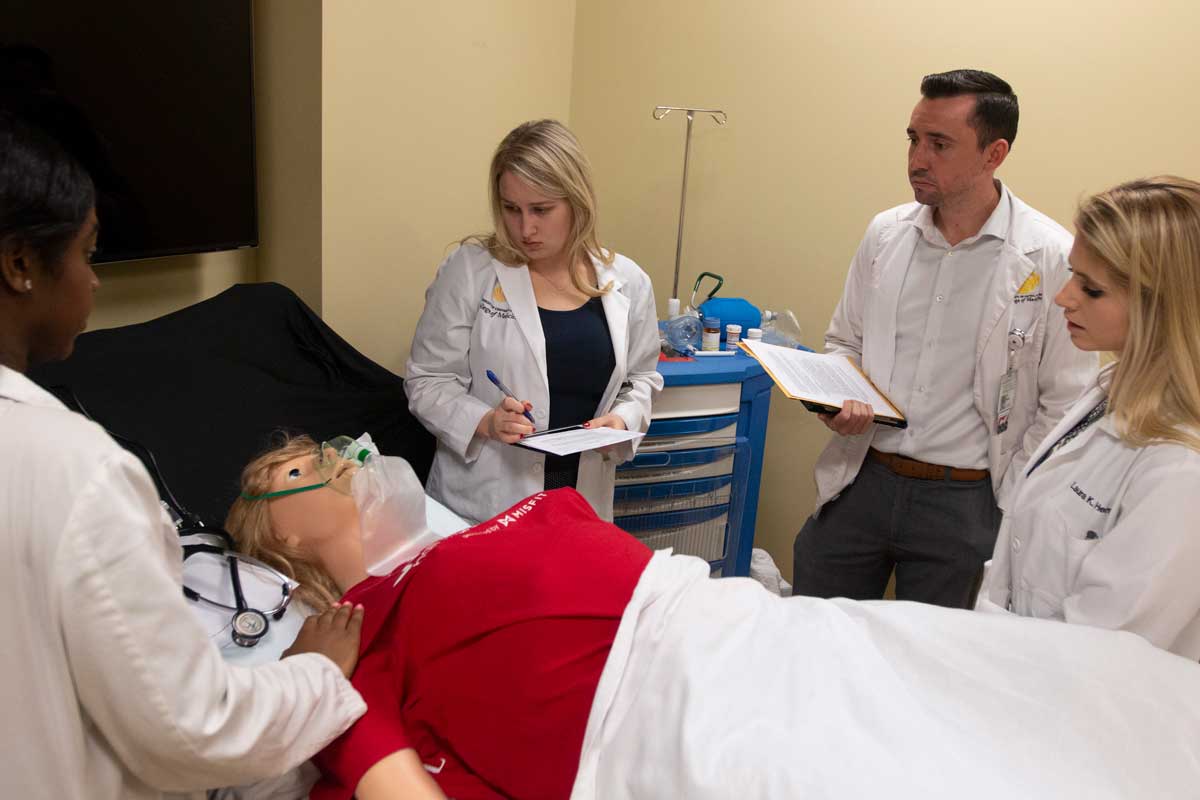“Can you hear me, Mr. Smith?” UCF medical student Monet Winslow questions as she leans over her patient, a 65-year-old man found unconscious in his home after an opioid overdose. As her teammate and classmate, Laura Herndon, sprays antidote up the man’s nose, Mr. Smith’s eyelids flutter open. “Where am I?” he asks, a confused look on his face.
But Mr. Smith isn’t a real patient. He is a computerized medical mannequin helping to train UCF medical students to deal with an emergency that’s becoming all too familiar as Florida and the nation battle opioid addiction.
“We see opiate overdoses on almost a weekly basis,” says Adam Benzing, a UCF emergency medicine resident at Osceola Regional Medical Center who helped supervise the simulation. “And especially with patients who are on chronic pain management, it’s not uncommon for them to mix their own prescribed medications.”
Florida has been especially hard-hit by the opioid crisis. In 2016, the state reported 2,798 opioid-related deaths. That’s 14.4 deaths per 100,000 people, exceeding the national average of 13.3, according to the National Institutes of Health.
Authorities say many of those deaths happened after patients were prescribed opioids for pain and then become addicted.
In response to the epidemic, the UCF College of Medicine created an opioid curriculum that spans all four years of medical school and has been recognized nationally by the Association of American Medical Colleges for its ability to train young doctors in the dangers of prescribing opioids for chronic pain. The Feb. 15 emergency room simulation was part of that effort.
“It’s an epidemic, and that’s one of the reasons we wanted students to get informed about how to handle something they’re going to see very frequently.” — Denise Kay, assistant professor at UCF’s College of Medicine
“It’s an epidemic,” says Denise Kay, an assistant professor at the College of Medicine, who oversaw the simulation. “And that’s one of the reasons we wanted students to get informed about how to handle something they’re going to see very frequently.”
For the simulation, Mr. Smith was on Percocet — an opioid — because of chronic back pain from a car accident. Not knowing the danger and tired of feeling pain, he decided to mix his usual painkillers with an over-the-counter pain medication. Neighbors found him unresponsive in a pool of vomit and called an ambulance. Now he was in the emergency room, just having regained consciousness and was bewildered.
UCF students broken into teams with each person responsible for a different aspect of the patient’s care. One of those aspects was ethical. Because the patient was unresponsive in the ER, he couldn’t give informed consent for treatment. When he regained consciousness, he protested that he couldn’t afford to be hospitalized and wanted to leave. What should the physicians-in-training do?
“You have to respect the patient and his autonomy, but at the same time, make sure that he recognizes he could die if he doesn’t get the proper treatment,” says Benzing. “And that can be a difficult thing to wrestle with.”
UCF medical student Josh Nims was working hard to get Mr. Smith to agree to stay in the hospital for additional treatment, but the patient initially refused. Nims realized he needed a different approach.
“I found myself saying, ‘Sir, we need to do this, we need to do that,’ when you know, in reality, we should say, ‘What do you think about us doing this?’ ” Nims says.
Other students were in charge of using their mobile devices to look up medication dosages and directing the proceduralist, another student role, to administer an appropriate dose of overdose antidote.
“Being an emergency physician, it’s very fast-paced,” says David Lebowitz, curriculum director for UCF’s emergency medicine residency program at Osceola Regional. “The challenge is there’s a large breadth of information that you have to know. We want the students to be able to retrieve and assess evidence-based resources at the bedside in an easy-to-use manner that they can then apply to the patient.”
Students say that working through the simulation was an important reminder that optimal patient care involves more than just treating the immediate illness.
“The students can interact with each other, interact with the patient and then also get real-time feedback afterwards to discuss how they can do it better.” — Adam Benzing, a UCF emergency medicine resident at Osceola Regional Medical Center
“When we’re first learning our clinical skills, there’s an emphasis on stabilizing the patient, acting in the moment,” says medical student Jaclyn Marrinan. “It’s important as we move forward to have that ethical and safety reminder.”
She notes that physicians not only need to consider the problem right in front of them, but also address, “what will we do after he’s stable to prevent this from happening again?”
Because the students were practicing in the Clinical Skills and Simulation Center, they could develop their skills in a “safe environment” before they confront real patients, Benzing says.
“The students can interact with each other, interact with the patient and then also get real-time feedback afterwards to discuss how they can do it better,” he says. “In that way, they’ll be better prepared for their actual clinical rotations.”




